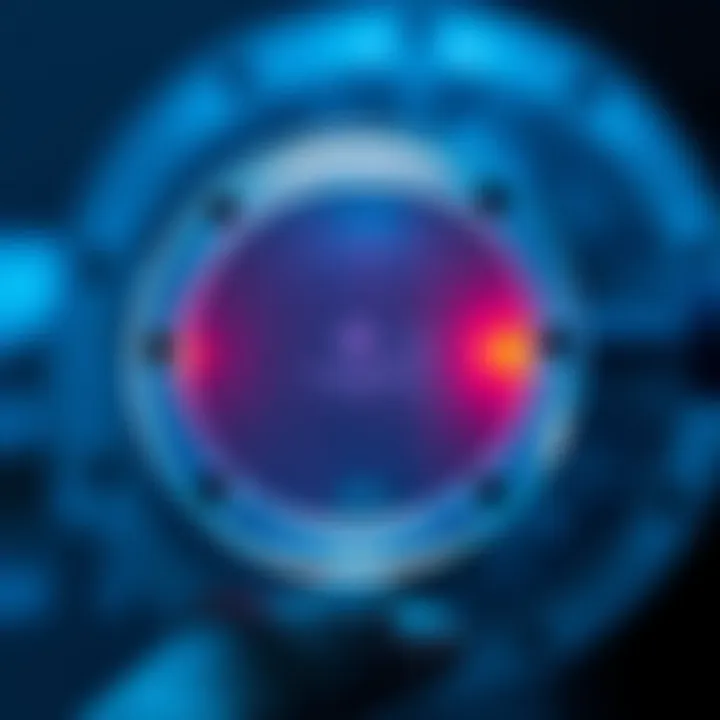Exploring Phosphor Plates: Mechanisms and Applications


Article Overview
Purpose of the Article
This article seeks to shed light on phosphor plates, an integral technology often overlooked in common discussions surrounding imaging and radiography. By dissecting their fundamental mechanisms, operation, and the various sectors where they find application, the aim is to provide a detailed picture of their role in modern science and industry. The discussion will also highlight ongoing developments and the promise of future innovations stemming from this fascinating technology.
Relevance to Multiple Disciplines
Phosphor plates are not just a niche interest; their utility cuts across multiple fields, making them relevant to a wide range of professionals.
- Medical Imaging: In healthcare, these plates enhance the accuracy and efficacy of diagnostics.
- Industrial Applications: They are invaluable in quality control and non-destructive testing procedures.
- Scientific Research: In laboratories, phosphor plates contribute significantly to experimental analysis and data collection.
Given their broad application spectrum, understanding phosphor plates is vital for anyone engaged in imaging technology, whether as researchers, educators, or practicing professionals.
Research Background
Historical Context
The journey of phosphor plates dates back several decades, rooted in developments related to luminescent materials. Initially, x-ray film was the predominant technology for imaging. However, the limitations of film—such as longer exposure times and the necessity for chemical processing—created an urgent need for more efficient alternatives. Phosphor technology emerged as a promising solution. Over the years, significant advancements have been made in the materials and techniques used, refining their capacity and usability.
Key Concepts and Definitions
Understanding phosphor plates requires familiarity with a few key concepts:
- Phosphorescence: This is the process by which certain materials absorb energy and then re-emit it over an extended period.
- Resolution: In terms of imaging, resolution refers to the detail an image holds. The higher the resolution, the more precise the details captured.
- Digital Radiography: A technology that replaces traditional film-based radiography with digital sensors, where phosphor plates hold a pivotal role.
By grasping these concepts, readers can start to appreciate the complexities and advantages of phosphor plates in various applications.
Phosphor plates represent a significant leap in imaging technology, combining efficiency with versatile applications across countless fields.
Phosphor plates represent a significant leap in imaging technology, combining efficiency with versatile applications across countless fields.
As we delve further, the sections that follow will explore the fundamental mechanisms that underpin phosphor plate technology, their wide-ranging applications, and the exciting challenges and future directions that lie ahead.
Foreword to Phosphor Plates
Phosphor plates represent a significant leap in imaging technology, blending efficiency with precision. This section aims to shed light on their nuances, covering fundamental aspects, historical backgrounds, and materials used. It’s not just about capturing an image; it’s about understanding the mechanisms that enhance diagnostic capabilities across various fields.
Definition and Historical Context
At its core, a phosphor plate is a type of imaging plate that utilizes photostimulable phosphors to capture and store images. The principle relies on the ability of these phosphors to temporarily store energy from incident radiation, be it X-rays or other forms of ionizing radiation. When stimulated by a specific wavelength of light, these materials release the stored energy, producing a visible image.
Historically, the evolution of this technology dates back several decades. Initially, radiographic techniques relied heavily on film, which, while effective, didn’t offer the same flexibility or efficiency as phosphor plates. The introduction of computed radiography in the 1980s marked a pivotal moment, allowing for quicker image retrieval and reduced radiation doses for patients. This evolution has dramatically transformed radiographic practices, paving the way for advancements that we see in modern medical imaging today, such as faster diagnostics and enhanced image clarity.
Basic Composition
What goes into a phosphor plate? Understanding its composition is critical to grasping how these materials operate. The most common phosphor used is barium fluorohalide doped with europium. This compound's unique properties allow it to absorb and store the energy from X-rays effectively.
Key components of phosphor plates include:
- Base Layer: This structural layer supports the phosphor layer, often made of materials like aluminum or polyester.
- Phosphor Layer: The active layer where image formation occurs; it absorbs radiation and stores the resultant energy.
- Protective Layer: A thin coating that guards against scratches and environmental factors, ensuring durability and longevity.
The blend of these materials not only enhances the imaging process but also optimizes the overall functionality of phosphor plates in various applications, from healthcare diagnostics to industrial inspections. Understanding how these components work together provides insight into why phosphor plates remain a mainstay in imaging technology, bridging gaps between traditional methods and contemporary needs.
Mechanisms of Phosphor Plates
Understanding the mechanisms of phosphor plates is vital for appreciating their functionality and versatility in various applications. At their core, these plates harness the phenomena of photostimulable luminescence, which allows for efficient image capture and readout. This technology stands as a significant leap ahead of conventional imaging techniques, primarily due to its capacity to capture and store images, enabling remarkable detail and clarity.
Principles of Photostimulable Luminescence
Photostimulable luminescence is the cornerstone of how phosphor plates work. When exposed to radiation, phosphor materials absorb energy, effectively storing it until stimulated by light. This characteristic is not only crucial for capturing images but also serves to enhance the quality of those images.


One key aspect of this process is the energy storage capability of the phosphor material. Materials such as barium fluorohalide are often employed due to their high sensitivity and ability to retain the energy for extended periods. Once stimulated by a laser during the readout process, the stored energy is released as visible light. This light is then detected and converted into a digital image. The efficiency with which phosphor plates utilize this energy can significantly contribute to reduced exposure times, which is particularly beneficial in medical imaging where patient safety is paramount.
Notably, the ability to integrate these principles into a compact system transforms traditional imaging workflows. By understanding these underlying mechanisms, professionals can better appreciate the advancements in design and functionality that phosphor plates offer.
Process of Image Capture and Readout
The process of image capture and readout involves several essential stages, mainly driven by excitation and stimulus, followed by subsequent signal detection. Each step plays a crucial role in the overall performance of phosphor plates.
Excitation and Stimulus
The initial phase of capturing an image involves excitation and stimulus, where the phosphor material absorbs incident energy from x-rays or gamma rays. This energy input excites the electrons within the phosphor, enabling them to move to higher energy states, thus storing this energy.
A defining feature of this process is its efficiency in translating radiation into a usable format for imaging. The speed with which this energy is stored is vital for reducing exposure times, ensuring that images can be captured quickly while maintaining the highest possible quality. This expediency is what makes excitation and stimulus a popular choice in fields like medical imaging where rapid diagnostics are essential. However, a minor downside is that the efficiency can vary based on the type of phosphor used.
Signal Detection
Signal detection is the following critical step in the imaging process. Once the stored energy is stimulated, it is released as visible light, which is then captured by a photodetector. This stage determines the quality of the final image, with several factors influencing the effectiveness of signal detection.
A prominent characteristic of signal detection is its role in translating the luminescent signals into digital data. This conversion process is key to ensuring that the images produced are both clear and detailed. Moreover, advancements in sensor technology can enhance this stage considerably, allowing for more sensitive detections that result in higher quality images. While the integration of sophisticated detection systems is advantageous, there can be challenges related to equipment costs and the need for regular calibration to maintain optimal performance.
"The magic of phosphor plates lies in their ability to provide high-quality images while minimizing radiation exposure, ultimately enhancing both patient and operator safety."
"The magic of phosphor plates lies in their ability to provide high-quality images while minimizing radiation exposure, ultimately enhancing both patient and operator safety."
In summation, the mechanisms of phosphor plates, driven by photostimulable luminescence, are what enable these devices to revolutionize imaging technologies. Understanding excitation, stimulus, and signal detection allows professionals to appreciate the nuances and potential that these systems offer in both medical and industrial applications.
Comparative Analysis with Traditional Imaging Methods
The discussion surrounding the comparative analysis of phosphor plates and traditional imaging methods is vital for understanding their role and impact in various fields. This analysis lays the groundwork for grasping the advantages, challenges, and overall effectiveness of phosphor plates, facilitating informed decision-making for users in medical, industrial, and research settings.
Advantages of Phosphor Plates
Image Resolution
When it comes to image resolution, phosphor plates shine like a beacon of clarity in the often murky waters of imaging technology. One specific aspect to highlight is their ability to capture fine details that traditional imaging methods may overlook. This level of detail is crucial in medical imaging, where accurate diagnosis often hinges on seeing the smallest of variations in anatomy.
Phosphor plates offer a superior key characteristic of spatial resolution when compared to X-ray films. The granularity and clarity of images produced allow radiologists and technicians to discern subtle abnormalities— a key reason why many facilities are shifting towards them.
Unique among their features, phosphor plates’ ability to adapt to a variety of imaging energies results in high-quality, crisp images that can be enhanced digitally without significant degradation. This makes them a popular choice in settings where precision is paramount, balancing cost-effectiveness while ensuring top-tier image delivery.
Dynamic Range
Dynamic range represents another critical aspect where phosphor plates excel, contributing significantly to capturing images in varying light conditions. This characteristic allows for a wider range of densities in captured images, meaning it can depict both shadows and highlights more effectively than traditional methods.
The ability to retain rich detail in both bright and dark areas offers a beneficial edge; medical professionals, for instance, require extensive tonal variations to accurately assess tissues without losing nuances in shading. Many users appreciate this feature because it enables a clearer interpretation of complex anatomical structures.
However, one should note that while phosphor plates’ dynamic range is an attractive characteristic, it may require careful calibration to ensure accurate readings in all conditions. This can be a downside in fast-paced environments where workflow efficiency is essential, yet the resulting image quality often justifies this trade-off.
Limitations and Disadvantages
Durability Concerns
This segment expands on durability concerns associated with phosphor plates, one of the pivotal limiting factors impacting their widespread adoption. Unlike traditional film, which is generally tougher and can handle exposure more robustly, phosphor plates are less durable in harsh environments. This factor plays an essential role in settings where equipment may be subjected to various levels of use or mishandling.
Moreover, the need for careful storage and handling to avoid damage or scratches can become a significant concern in busy hospitals or laboratories. Users must employ extra caution— a drawback that may hinder their integration into environments that typically require more rugged equipment.
Cost Implications
Cost implications are ever-present in any investment decision regarding technology, and phosphor plates are no exception. While they provide numerous benefits, the initial costs and ongoing maintenance can be a roadblock for some facilities, particularly smaller practices or startups.
An important aspect regarding costs is that although phosphor plates can offer potential savings over time by reducing film and developing costs, the upfront expenditure often deters immediate transition. It’s vital to weigh the long-term effectiveness against the short-term financial strain.
In summary, while the comparative analysis of phosphor plates with traditional imaging methods sheds light on their advantages—such as superior image resolution and dynamic range— it also calls attention to critical considerations like durability and cost. Both elements must be assessed to make informed choices that enhance operational efficiency and quality of output in various fields.


Applications in Medical Imaging
The use of phosphor plates in medical imaging marks a significant leap in how diagnostic procedures are conducted. These plates facilitate high-quality image capture while offering a range of benefits that enhance patient care and clinical efficiency. This section illustrates the key applications of phosphor plates within the realms of radiography and fluoroscopy, and their integration in computed tomography, further demonstrating their relevance in modern medical practices.
Radiography and Fluoroscopy
Phosphor plates are pivotal in the fields of radiography and fluoroscopy, primarily due to their ability to capture images with exceptional clarity. Unlike traditional film methods that can be cumbersome and slower, phosphor plates provide a fast response time and dynamic range that optimizes both image quality and patient throughput.
The mechanism behind this starts with the photostimulable luminescence properties inherent to phosphor plates. When exposed to ionizing radiation, the plates store energy temporarily and release it in the form of visible light when stimulated by a laser during the readout process. This light is then converted into a digital image, allowing for immediate assessment.
Some of the notable advantages of using phosphor plates in radiography include:
- Enhanced Image Quality: The plates can yield higher resolution images with greater detail, which is critical for accurate diagnostics.
- Reduced Radiation Exposure: Since the plates are more sensitive to radiation, they often require less exposure than traditional film, minimizing risk to patients.
- Streamlined Workflow: The digital output allows for rapid sharing and analysis of images within the healthcare environment, improving decision-making.
Fluoroscopy, which involves real-time imaging, benefits similarly from the operational speed and sensitivity of phosphor plates. This method is particularly beneficial for procedures that necessitate live imaging, such as catheter placements or gastrointestinal examinations. In these cases, the efficiency of phosphor plates not only enhances diagnostic capabilities but also significantly contributes to patient comfort and safety.
Computed Tomography Integration
The integration of phosphor plates in computed tomography (CT) represents another significant advance in imaging technology. Traditional CT scanners often rely on more complex and expensive systems; however, when phosphor plates are incorporated, these systems can leverage their unique properties, making the process both efficient and cost-effective.
Phosphor plates used in CT create a bridge between conventional imaging techniques and cutting-edge digital enhancements. By employing a technique known as computed radiography, healthcare providers can convert the analog information captured by phosphor plates into high-resolution digital images that are ready for instant analysis.
The benefits in this context are manifold:
- Cost-Effectiveness: Integrating phosphor plates into CT systems can reduce operational costs, making imaging more accessible to a broader range of healthcare facilities.
- Improved Diagnostic Accuracy: The high image quality of phosphor plates aids in distinguishing between various tissue types, thereby aiding clinicians in making more accurate diagnoses.
- Adaptability in Various Settings: Phosphor plates can be used in different imaging modalities, providing versatility that is particularly valuable in diverse clinical environments.
The transition towards incorporating phosphor plates in CT imaging is a promising trend that aligns with evolving healthcare needs—paving the way for better diagnostic practices that prioritize speed, accuracy, and patient safety.
Using phosphor plates in medical imaging is not just about enhancing image quality; it’s about redefining the standards of patient care and technological integration in the field.
Using phosphor plates in medical imaging is not just about enhancing image quality; it’s about redefining the standards of patient care and technological integration in the field.
By emphasizing these applications, the medical community can better appreciate the significance of phosphor plates in both current practices and future advancements.
Industrial and Scientific Applications
Phosphor plates have carved out a pivotal niche in both industrial sectors and scientific research. Their unique mechanisms not only translate to significant operational advantages but also provide routes to innovative solutions in various fields. Understanding these applications allows for a greater appreciation of how these tools shape efficiency and accuracy.
Quality Control in Manufacturing
In the industrial landscape, ensuring the quality of products is a non-negotiable aspect. Phosphor plates come into play, revolutionizing the way quality control is performed. These plates enable detailed imaging that can uncover even the slightest flaws in materials.
With the ability to capture high-resolution images, they are invaluable for detecting defects during the manufacturing process. Incorporating phosphor plates into quality assurance workflows enhances both precision and reliability. For instance, in the automotive industry, flaws that might not show up in standard inspection methods can be easily identified through the detailed imaging produced by phosphor plate systems. This leads to reduced wastage and improved safety standards.
Moreover, these plates can handle a wide range of materials, making them versatile. They are conducive to various forms of testing, such as stress testing and non-destructive testing, ensuring that the manufactured products meet the stringent safety and quality standards set forth by regulatory bodies. Investing in quality control processes utilizing phosphor plates not only streamlines operations but also contributes positively to the bottom line.
"Quality is not an act, it is a habit." - Aristotle
"Quality is not an act, it is a habit." - Aristotle
This approach doesn't just align with the aim of zero defects; it fosters a fine-tooth-comb scrutiny that avoids costly recalls and fosters customer trust.
Research and Development in Physics
Phosphor plates also play a substantial role in the realm of scientific inquiry, particularly within the field of physics. They are utilized for conducting research that demands precision and reliability. In experimental physics, for example, these plates can capture and preserve data from high-energy collisions that are pivotal in particle physics studies.
When researchers at CERN or similar institutions need to visually document the outcomes of particle interactions, phosphor plates provide a robust solution. Their capacity to record high-energy data while maintaining high resolution allows scientists to analyze phenomena such as the behavior of subatomic particles in detail.
Additionally, in laboratories focused on material science, phosphor plates assist in studying the luminescent properties of various substances. These investigations hold the potential to reveal new materials that could outperform current technologies. The ability to visualize excitations and their subsequent decay on phosphor plates opens up avenues for fresh discoveries.
Another aspect is the adaptability of these plates – as researchers innovate, so do the applications of phosphor plates within their experiments. Whether studying quantum computing or exploring nanotechnology, this technology accommodates changing needs and methodologies, lending itself to a future that awaits further exploration.


In summary, whether it's ensuring the safety of consumer goods through quality control or delving into the mysteries of particle physics, the industrial and scientific applications of phosphor plates are both extensive and significant. Their versatility in various fields ensures they will remain a crucial resource in advancing technology and knowledge.
Innovations and Future Trends
Innovation drives the evolution of technology, and phosphor plates are no exception. Staying relevant in today’s fast-paced environment means adopting new strategies and methodologies that enhance functionality and efficiency. In the context of phosphor plates, this involves tapping into advancements in material science and merging these with digital technologies. The importance of this topic cannot be overstated; aligning phosphor plate technology with current trends enables applications across a wider field and fosters new possibilities, making it an essential discussion point in our exploration.
Advancements in Material Science
The ongoing evolution of material science has opened doors for significant improvements in phosphor plate technology. New materials not only enhance the performance of phosphor plates but also make them more sustainable. The recent leap in nanotechnology, for instance, has led to the development of luminescent materials that offer higher sensitivity and resolution. This can improve the clarity of images, allowing for more precise diagnostics in medical applications.
- One exciting aspect is the exploration of quantum dots as luminescent materials. These nanometer-sized particles can provide more vivid colors and better image resolution than traditional phosphors. Their ability to be tuned for specific wavelengths opens up avenues for advanced imaging techniques.
- Moreover, researchers are looking at doped materials, where specific impurities are added to enhance luminescent properties further. This fine-tuning leads to phosphor plates that are not only more responsive but also adaptable to various imaging needs across fields.
- Studies have shown that certain compounds can significantly decrease the signal loss that has plagued earlier phosphor plate designs. By enhancing the retention of emitted light, practitioners in fields such as radiography can expect longer operational lifetimes and improved efficiency.
These developments signal a shift towards more specialized phosphor plates, tailored to meet the demands of diverse applications, from medical imaging to industrial quality control.
Integration with Digital Technologies
Another essential trend in the future of phosphor plates is their integration with digital technologies. This fusion is much more than a passing fancy; it’s a game-changer that promises to reshape how we perceive and utilize imaging technologies. The interplay between physical phosphor plates and virtual systems leads to a myriad of benefits.
- For starters, integrating phosphor plates with digital sensors enables real-time imaging. This characteristic allows for instant analysis of images, reducing wait times significantly in settings such as emergency radiology. The capabilities of modern digital technologies aim to complement the details captured by phosphor plates, producing sharper and more reliable diagnostics.
- Furthermore, digital platforms can facilitate the storage and retrieval of images, thus, ensuring that important data is kept secure yet easily accessible. This offers healthcare professionals seamless access to patient histories while maintaining high standards of privacy and safety.
- The growing prominence of artificial intelligence in image analysis cannot be ignored either. AI algorithms can assist in interpreting images produced by phosphor plates, enhancing efficiency in diagnostics. With machine learning, these systems evolve to deliver more precise evaluations over time.
- Collaborative tools powered by cloud technology also allow healthcare professionals and researchers to analyze data collectively, regardless of geographic locations. This capability transforms traditional imaging practices into more flexible and interactive mediums.
In synthesis, the future of phosphor plates seems bright as researchers scrutinize not only the underlying materials but also how these technologies can function in our increasingly digitized world. Staying ahead means embracing these innovations, thereby crafting better solutions tailored for contemporary challenges and expected advancements.
Environmental and Safety Considerations
Understanding the environmental and safety implications of phosphor plates is crucial as the demand for innovative imaging solutions continues to rise. Phosphor plates, while highly effective, come with responsibilities that must be managed to ensure the safety of both users and the environment. This section will explore two key areas: the impact on waste management and the protocols surrounding radiation safety.
Impact on Waste Management
The use of phosphor plates generates specific waste that necessitates thoughtful disposal practices. Unlike traditional film, which often contains silver and can be hazardous to the environment, the waste from phosphor plates typically consists of materials that are less harmful. However, that doesn’t mean they should be tossed aside without proper consideration.
- Disposal: Phosphor plates can be toxic if not disposed of correctly. Facilities that use them need to adopt waste management strategies that minimize the environmental footprint. Regulations vary by region but generally include proper disposal in specialized facilities.
- Recycling Opportunities: There is a growing trend toward recycling materials from phosphor plates, which can reduce waste while recovering valuable resources; efforts are underway to develop processes for reclaiming useful materials from expired plates.
- Lifecycle Analysis: It's also crucial for practitioners to understand a phosphor plate's lifecycle. From raw material extraction to disposal, assessing this lifecycle helps in identifying areas for improvement in sustainability practices.
By being proactive in these areas, manufacturers and users alike can lessen their ecological impact while still reaping the benefits of phosphor plate technology.
Radiation Safety Protocols
When working with imaging technologies, particularly those involving radiation, safety cannot be overstressed. Phosphor plates are typically considered less hazardous than methods requiring direct radiation exposure. However, there are still safety protocols that need to be upheld to protect both personnel and patients:
- Personal Protective Equipment (PPE): Anyone handling phosphor plates should wear suitable PPE, including lead aprons, to minimize exposure.
- Proper Handling and Storage: Ensuring that phosphor plates are stored in controlled conditions prevents accidental exposure to damaging radiation and ensures the longevity of the plates.
- Training and Awareness: Staff operating imaging equipment must receive comprehensive training on the risks and safety measures associated with radiation. Encouraging a culture of safety can reduce risks immensely.
- Regular Safety Checks: Implementing routine inspections and checks ensures compliance with established safety standards, and helps in identifying potential risks before they escalate.
These protocols provide a critical foundation for maintaining safety within environments utilizing phosphor plate technology. By prioritizing adherence to these measures, organizations can effectively mitigate potential risks, thus maintaining a safe atmosphere for both operators and patients.
"Planning for environmental stability and safety is key to the future success of phosphor plate applications, ensuring that technology advances without compromising health and ecological integrity."
"Planning for environmental stability and safety is key to the future success of phosphor plate applications, ensuring that technology advances without compromising health and ecological integrity."
The understanding of environmental and safety considerations surrounding phosphor plates diverges into necessary actions that not only protect health but also the planet. As this technology evolves, continuing education and adaptation to regulations will play an essential role in sustainable practices.
Ending
In this article, we have explored the intricate world of phosphor plates, revealing their significance in various imaging domains and understanding their underlying mechanisms. As we reflect on their journey, it becomes evident why phosphor plates are not just an accessory in imaging technology but a crucial player that blends efficiency with quality.
Recapitulation of Phosphor Plate Significance
To recap, phosphor plates serve as a bridge between older imaging techniques and the advancements in digital technology. Their role in medical imaging is profound, allowing for fine resolution without the substantial exposure risks tied to traditional X-ray films.
Moreover, industries rely on them for quality control, ensuring that products meet stringent standards before hitting the market. The ability to capture and retain images that can be read with minimal degradation enhances their appeal across various sectors including pharmaceutical and manufacturing industries. Here are some key points about their significance:
- Image Quality: The high resolution and detail captured in images.
- Efficiency: Reduced time in imaging processes compared to conventional films.
- Versatility: Adaptable to various environments and applications.
Phosphor plates have positioned themselves as essential instruments not only for their technical capabilities but also for the broader reduction of hazardous waste in comparison to traditional methods.
Final Thoughts on Future Directions
Looking forward, the future of phosphor plate technology seems promising yet challenging. Advances in material science may lead to the development of plates with enhanced sensitivity and durability, further solidifying their place in both medical and industrial fields.
The integration of phosphor plates with cutting-edge digital technologies such as machine learning analytics can usher in an era of smarter imaging, enabling doctors and technicians to make quicker and more informed decisions. Future research could expand their applications even further, exploring uses in environmental studies and non-destructive testing.
In summary, the potential for phosphor plates to evolve alongside emerging technologies is vast. The anticipated innovations will not only refine existing methods but also open up new avenues for exploration. As we stand on the brink of progressive advancements, it’s clear that phosphor plates will continue to spark innovation across numerous fields, remaining a linchpin in imaging solutions.



